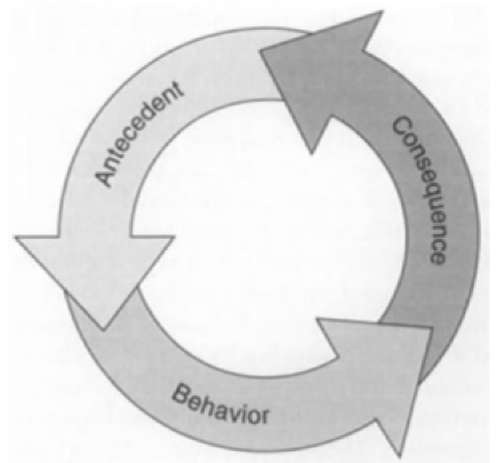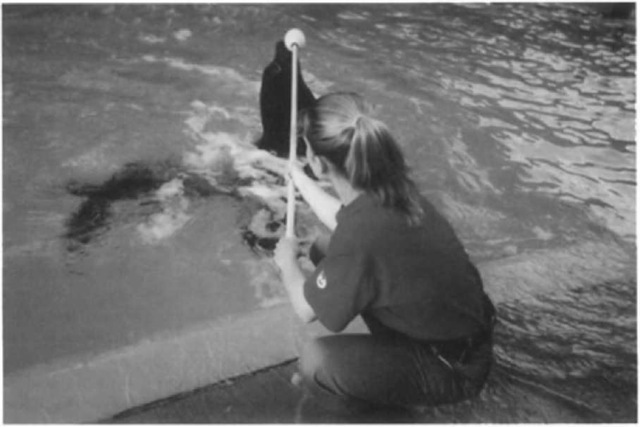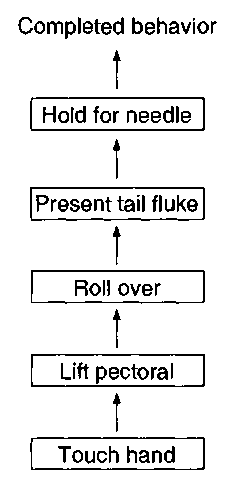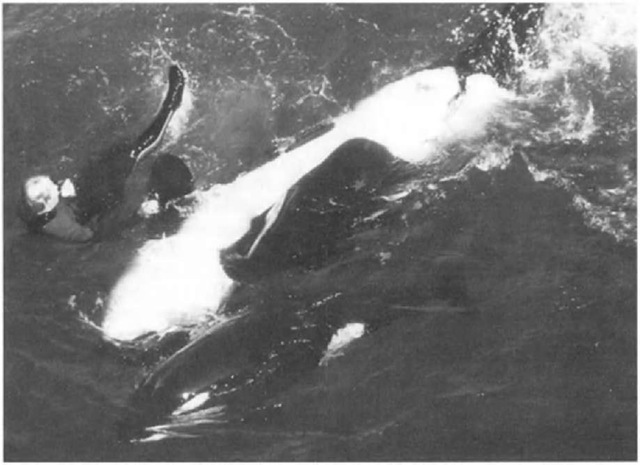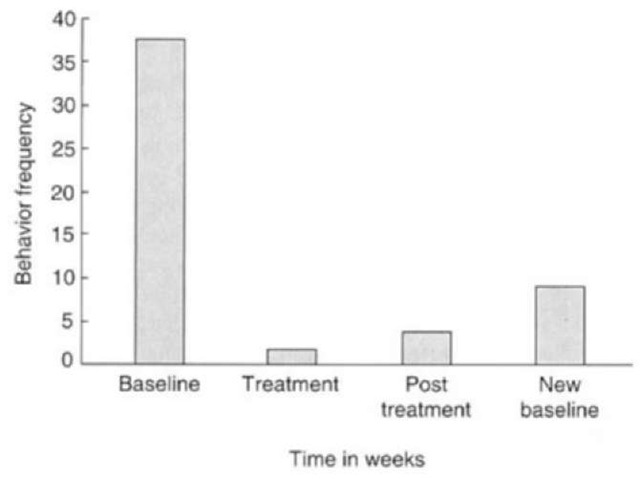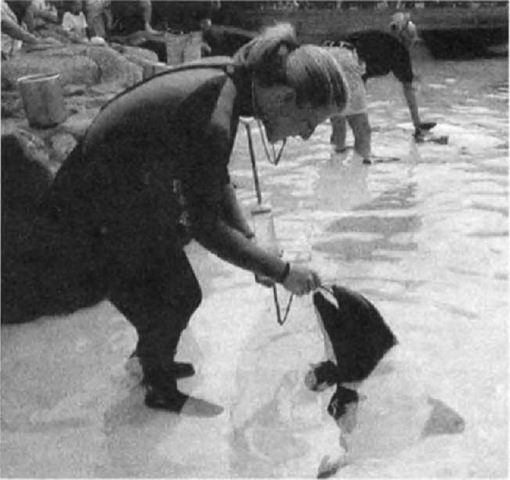Marine mammal training is a relatively new field that gained formal recognition in the late 1940s. One of *”- the first institutions to successfully maintain a breeding colony of bottlenose dolphins, Marineland of Florida also became the first institution to begin a formal training program for bottlenose dolphins (Tursiops truncatus). As behavioral observations of these animals began to generate questions unanswerable through scientific observation alone, it seemed that further exploration involving dolphin-learning abilities could only be facilitated through training. Early training methods were considered industry secrets, yet those techniques were primitive. Although the methods used at that time were limited, consisting of trial and error, the marine mammal training field now employs proven behavior modification principles and, most predominantly, operant conditioning (behavior that is modified by the consequences) as a means to teach various behaviors to marine mammals. While the use of operant conditioning is not the only mechanism used to train marine mammals, it is arguably the most productive. Therefore, the fundamentals of this science must be assimilated in order to be successful at training marine mammals. Because the field of marine mammal training minimizes the use of punishment techniques, it is highly productive and continues to stand as a model for ethical training. The high exposure and excitement that is created when performing for the general public has focused attention on the cognitive abilities of these animals. Although some disagree with the use of animals in show performances, most are fascinated by the level of complexity, coordination, and consistency in behavior. Still others are amazed at the degree of intimacy and interaction between animal and trainer. Magical to some and practical to others, it is the training process itself that creates the medium for “communication” between marine mammal behaviorists and the animals they closely interact with. In most cases, the shows provide the animals with stimulating enrichment and the general public with the motivation for further education (Fig. 1).
I. Animal Learning and Behavior
Learning is a fundamental biological process necessary for survival. The expression or suppression of certain behaviors enable animals to respond to their environment and adapt to social and environmental changes. The detailed study of animal learning primarily involves aspects of psychology, such as memory, developmental learning, classical conditioning, operant conditioning, behavior modification, cognition, and other information processing disciplines. When describing the main components of current marine mammal training, the following three primary learning modes become salient.
Figure 1 Marine mammal training and show performances generate public interest in marine mammals and related issues.
A. Observational Learning
Also known as modeling, this vicarious process is defined as learning by observing another (model) engage in a behavior. During observational learning, the animal (observer) need not emit the observed behavior nor receive direct consequences in order that learning occurs. Mimicry seems to be a by-product of observational learning. It is a primary learning element for young animals raised in a complex social environment and appears to be of significance in developing socialization skills. The expression of these mimicked behaviors is not relegated to social behavior only. Young marine mammals will attempt to mimic trained behaviors and will often accompany adults in show performances or training sessions. It is common practice for marine mammal behaviorists to “capture” (reinforce) mimicked behaviors in order to rapidly develop and accelerate the learning process for young animals. However, regression often occurs when the model (adult) is no longer present. Training programs that rely on observational learning must often retrain these animals using direct operant conditioning and behavior shaping with individual training sessions. Nonetheless, observational learning plays an important role in the lives of marine mammals.
B. Classical Conditioning
Past understanding of Ivan Pavlov’s early work investigating anticipatory salivation in dogs led to a restricted view that classical conditioning [the pairing of a conditioned stimulus (CS) in conjunction with an unconditioned stimulus (UCS)] only produced learning involving reflex systems. In recent years, this view has been replaced with a more contemporary understanding. Associations between conditioned and unconditioned stimuli have been linked to learning phenomena such as sign tracking (movement toward a stimulus that signals the availability of a positive reinforcer such as food), conditioned emotional response (fear), and taste aversion (food preference/avoidance). These seemingly insignificant components have a major impact on subsequent learning during the training process. Accidental pairing of events can create learning via classical conditioning that can interfere with or influence the training of marine mammals. Associating food with a loud noise, for example, can eventually diminish the startle effect the noise might otherwise evoke. However, pairing that same loud noise with a painful medical procedure can exacerbate the negative reaction to that same noise in the future. A minor avoidance response by die animal could intensify into a severe aggressive or panic response, causing injury to the animal or the animal handlers. An experienced marine mammal behaviorist understands this relationship and its effects on the training process. Classical conditioning can be used to help modify behaviors needed for the long-term care of marine mammals, such as introducing new animals into established social groups.
C. Operant Conditioning
Defined as behavior that is modified by its consequences, operant conditioning is currently recognized as the most widely employed training program for marine mammals. The basic components of instrumental learning (learning that occurs as a result of operant conditioning) must occur in precise order for learning to be achieved. These three components are the antecedent (a stimulus that precedes the behavior), the behavior (the resultant observed response emitted by the animal that immediately follows the antecedent), and the consequence (a stimulus that immediately follows the response and acts to increase or decrease that behavior). During a training session, a hand signal (antecedent) is usually presented to the animal followed by the animal’s response (behavior). If correct, the behavior is usually reinforced (consequence) by the trainer with either primary reinforcement (food) or secondary reinforcement (touch, toys, play, activities). Common in marine mammal training, incorrect behaviors are usually ignored with minimal or no consequence applied. Punishment and negative reinforcement are generally avoided. Other animal training fields use a wide variety of punishment and negative reinforcement techniques to suppress unwanted behavior. In the operant process, each behavior is best described as a learning cycle (Fig. 2).
Principles supporting the successful, technical application of these three elements must be understood by the behaviorist and include stimulus consistency, stimulus fading, behavioral criterion, behavioral development, delay of reinforcement, schedule of reinforcement, magnitude of reinforcement, and many others. Successful marine mammal trainers understand the implications of precise application. Like other forms of learning, operant conditioning should not be characterized as a “technique” or “system” of training that can be switched on and off conveniently, instead it is a dynamic and ever present environmental learning phenomena that is in continuous action, influencing the acquisition or extinction of specific behaviors. Behaviors are in the constant process of strengthening or diminishing as a result of the consequences that follow. It must be emphasized that not all of the antecedents and consequences experienced by each animal are applied by the marine mammal trainers. Behaviorism views the environment in its entirety with many such antecedent stimuli being processed by the animals in context. Even in the most productive marine mammal training programs, it is rare that more than 3 hr per day, on average, are devoted to actual training sessions, leaving 21 hr per day to other environmental learning influences. For large institutions with formal marine mammal training programs, certain principles and techniques have been refined and opera-tionalized to facilitate staff development and expertise, resulting in efficient animal training. Expertise is often gained through practical hands-on application and is supplemented with course work, seminars, and testing. Other mediums, such as conference attendance and trade groups, provide additional sources of information. The International Marine Animal Trainers Association (IMATA) is an established trade group that offers opportunities to formally exchange specialized marine animal training information. Many marine mammal training programs usually emphasize the following.
Figure 2 A typical operant conditioning cycle where the signal (antecedent) precedes the response (behavior), followed by the reinforcement (consequence). A single training session includes many such cycles.
1. Establishing “Trust” As an anthropomorphic expression, the word “trust” is used here to describe a more complex set of behavior. Naive animals (animals without prior training experience or a limited behavior repertoire) often seem cautious and wary of their surroundings. This apprehension can be reduced by minimizing or eliminating those practices that create avoidance or fear response, such as rough handling, aversive procedures, and loud noises. The process of extinguishing avoidance behavior is aided by the cumulative, positive effect of daily feedings and time spent with the animal. Within a few days, marine mammals will readily take food from the familiar hand and allow some calm touching during feeding. This provides the foundation for positive reinforcement (a stimulus that is applied as a consequence and increases the frequency, intensity, and duration of the preceding behavior). Regression can be minimized if aversive events can be delayed or eliminated. As a reinforcement history develops, unavoidable aversive events (such as routine medical treatment) have less impact and cause minimal regression. The opposite appears to be true as well. Repeated aversive procedures early in the process can have a profound negative effect and will delay the positive response to the trainer.
2. Conditioned Reinforcer The consistent pairing of a stimulus with the applied reinforcer (initially food) establishes the foundation for a conditioned reinforcer (a stimulus that has acquired reinforcing properties through learning). Most marine mammal training facilities call this a “bridging” stimulus. This bridging stimulus acts as a cue that signals the application of reinforcement (a stimulus that increases the frequency, intensity, and duration of a preceding behavior). It is referred to as a “bridge” because it acts to bridge the time delay between the precise behavior targeted for increase and the positive reinforcement. Marine mammal trainers and behaviorists use a variety of tools that act as a bridge. Typically, a high-frequency whistle is used for cetaceans (due in most part to higher hearing ranges), whereas a verbal cue or clicker sound is used for other marine mammals. This bridging stimulus, when paired consistently with the offering of food, quickly becomes recognized by the animal. Soon the sound itself evokes a response and subsequent orientation back to the trainer.
3. Building the Attention Threshold In order to maintain the animal’s attention sufficient to advance learning, an early emphasis on attention threshold (the duration that a stimulus will control behavior) is necessary. This is done by systematically increasing the amount of time the animal will continue to watch the trainer prior to bridging and reinforcement delivery. Increments of a few seconds are literally counted by the trainer when shaping an increased attention span. Eventually, within a few days or weeks, an attention span of several minutes can be conditioned if bridging/reinforcement is precise. Conversely, a lack of precision can delay progress. Inexperienced or impatient marine mammal trainers often overlook this critical element.
4. Following a Target If the pairing of food with the bridge has been well timed and effective, the animal will quickly learn to touch a hand prior to the bridge and food delivery. By holding the hand close to the animal, the animal will, in all likelihood, touch the hand. The behavior of touching should be reinforced. Eventually, the hand can be moved back and forth in order to strengthen the “following” response. In time, the animal will move to the hand wherever it is. Target poles (a long pole with a small round float attached to the end) are often introduced at this stage to simulate an extended reach. Through the use of this target pole, touching and following can be reinforced. Various behaviors can now be shaped through approximations (Fig. 3).
5. Achieving Stimulus Control As animals begin to learn the relationship between their emitted response (behavior) and the delivery of reinforcement by the trainer (consequence), they also begin to learn which specific behavior will be actually reinforced. Discrimination between learning events occurs when animals learn to respond differently to differing signals (antecedent). The trainer offers reinforcement only for specific responses and thereby facilitates discrimination. This process is aided through the use of specific hand signals (discriminative stimuli) that precede each behavior. When trainers selectively reinforce only desired behaviors, animals learn to recognize the signals and respond appropriately. This is referred to as stimulus control where behaviors are reinforced in the presence of a particular signal or stimulus. Random sampling (performing several behaviors in an attempt to gain access to reinforcement) is a common phenomenon early in the training process. Trainers will ignore all but the requested behavior, thereby aiding the process of stimulus control and discrimination learning.
Figure 3 A California sea lion (Zalophus califonianus) is trained to follow a target pole. The target eatables the trainer to shape behaviors from a distance.
6. Successive Approximations Effective trainers break each behavior down into small, easily understood and planned steps. For example, a high jump begins with the lifting of the head in order to touch the target pole and receive reinforcement. With each successive approximation, the target is raised slightly until the desired height is achieved. In effect, each behavior can be visualized by the trainer as a step-by-step process. All behaviors can be broken down in such a manner creating an easier learning process for the animal (Fig. 4).
Figure 4 An approximation diagram of a voluntary blood sampling behavior. Approximations can best be described as small “steps” toward a desired goal. Each step represents an advancing behavioral criterion progressing tankard the completed behavior. Here, a dolphin is first conditioned to allow a touch of the pectoral flipper. As this behavior is reinforced, the animal learns to follow the trainer’s hand with its pectoral flipper into a roll-over behavior. The roll-over behavior is then reinforced, and the animal learns to present itself in a belly-up position after a few trials. At this point, the trainer begins to reinforce the animal for allowing contact systematically closer to the tail flukes. After a few training sessions, the flukes can be held while a needle is slowly inserted for blood removal from a near surface vein. The trainer delivers reinforcement if the animal remains calm and motionless.
7. Schedules of Reinforcement This refers to the timing and frequency of reinforcement. As mentioned previously, most all marine mammal training programs emphasize positive reinforcement and generally avoid negative reinforcement (an increase in a response that causes the removal of an aversive stimulus) and punishment (a decrease in a response that is followed by an aversive stimulus). In fact, many marine mammal institutions now consider punishment unethical. Even so, an emphasis on positive reinforcement without regard to the precise schedule of reinforcement can lead to training and subsequent learning problems. Schedules of reinforcement have been derived empirically with many variations currently being studied. Each specific schedule has been shown to manifest certain behavioral characteristics. For example, a simple fixed ratio schedule (where a fixed number of responses is required for reinforcement) can create predictability in the environment and will manifest in episodic motivation with periods of poor response. These behavioral pitfalls are avoided when behavior programs include staff training on the most effective use of reinforcement. It would be an oversimplification to describe the most effective schedule of reinforcement, as each can be equally effective depending on the learning stage of the animal. In general, however, many applied marine mammal training programs are beginning to recognize the importance of variable schedules of reinforcement, including reinforcement variety. Variable schedules of reinforcement provide reinforcement intermittently and unpredictably. This more closely replicates the type of reinforcement schedule most often associated with the wild environment. The challenge of failing and then obtaining primary reinforcement (that which does not depend on learning such as food and water) and secondary reinforcement (an event that becomes reinforcing through learning such as play, games, toys) activates cognition and problem solving. This, in turn, provides enrichment opportunities for each animal while it shapes stronger foraging and hunting skills. (Clearly, it seems logical that an animal that learns to preserve after failure might have a higher survival rate in the wild.) Reinforcement variety (the random delivery of both primary and secondary reinforcement) augments the elements of surprise—an essential component of effective reinforcement.
As mentioned previously, only certain components of operant conditioning have been briefly described for the purpose of identifying those elements that influence the acquisition of trained behaviors most rapidly. Even those institutions that ignore or minimize the use of “training” are most certainly creating positive and negative consequences for behaviors. Formally applied or not, the process of “training” through both operant and classical conditioning continues for the animals. Consider the normal operation of daily cleaning, feeding, and watering. These activities can effectively act as consequences that shape and modify behaviors. The appearance of a cleaning hose, for example, might act as a punisher for certain animals, thereby suppressing the behavior of courtship (depending on the timing of its appearance). However, it could also act as a reinforcer for a different animal, thereby increasing the behavior of vocalizing (again dependent on the timing of appearance). Even stereotypic patterns, such as anticipatory pacing prior to feeding time, create an opportunity for adventitious reinforcement (coincidental cause and effect reinforcement causing an inadvertent increase in the unwanted behavior). Awareness of these learning principles enables caretakers, behaviorists, scientists, and trainers to better understand all environmental factors influencing the expression of appropriate or inappropriate behaviors. As we continue to learn about information processing and training, much more needs to be assimilated by the behaviorist. Memory retrieval, short- and long-term memory capacities, can influence behavior acquisition, especially in higher order animals. Learning phenomena such as context-specific learning (learning in one environment that does not necessarily transfer to another environment) can affect the outcome of a reintroduction project, for example. Further investigations into animal emotion and cognition will add enormously to our understanding of animals as will further studies to determine stage-developmental learning.
II. Early Development and Learning
During the first few days of life, the primary challenge for newborns is maternal acceptance. It seems that a mothers instinctive epimeletic (caregiving) behavior patterns should engage automatically after birth, yet newborns are sometimes rejected and thus are unable to survive. Still others have been injured and even killed by their mothers. This disturbing pattern, although rare, has also been observed in most mammal species (both wild and captive animals), including humans. The wide majority of newborns, however, are accepted (some immediately after birth and some within a few hours) and their mothers usually allow them to nurse within 24 hr. On rare occasion, offspring have gone 48 hr without taking their first milk. Within a few days, the calf or pup rapidly acquires the motor skills necessary to coordinate successful nursing while its mother is also acquiring and strengthening her own epimeletic repertoire, thereby increasing survivability in subsequent offspring. For the newborn, motor skill development occurs rapidly and, within a few weeks, observations of increasing independence (time and distance away from the mother) begin to emerge as coordination, buoyancy control, visual acuity, echolocation, and auditory learning strengthen. Observational learning becomes evident and mimicry increases until the young animal learns to directly manipulate its environment (Fig. 5).
In some cetaceans, between 4 and 7 months of age when teeth begin to erupt and grow, the mother initiates a weaning process through food sharing (either partially digested and regurgitated or with food that has been ripped into small pieces). This seems to coincide with accelerated learning and may signal the beginning of a sensitive learning phase or critical period (a period of rapid acquisition of behaviors). For marine mammals born in captivity, most formal training begins during this stage.
III. An Emphasis on Positive Reinforcement
Marine mammals respond readily to operant conditioning, probably the most widely used training process, and possess a strong aptitude for instrumental learning. The rapid acquisition of behaviors has done little to refute the notion that marine mammals are unusually “intelligent.” It must be stated, however, that other animals trained via operant conditioning sometimes show an equal or superior aptitude and learning curve. As stated previously, most marine mammal training programs restrict the use of punishment and applied negative consequences. Instead, they rely heavily on positive reinforcement. Empirical evidence suggests that positive reinforcement has a much greater influence in motivating animals to voluntarily engage in behaviors, whereas punishment suppresses the expression of behavior. Additionally, punishment serves to increase the development of undesirable behaviors, such as anxiety, escape, active and passive avoidance, frustration, aggression, and learned helplessness (a state of “giving up”). Training programs that use punishment must increase the frequency, intensity, or duration of the punishment in order to maintain its effectiveness. In time, these types of animal training programs develop animals with significant behavioral difficulties, increased stress, and a loss of motivation. The most effective training process develops a foundation of trust through daily care with the elimination of punishment. Most importantly, the desired outcome is voluntart/ cooperation as opposed to compliance under the threat of retaliation. This, at once, seems the most simple and the most difficult concept for the layperson to grasp. However, it may be the marine mammal training industry’s most profound contribution to the social sciences.
Figure 5 Young animals often learn through observation. Here, a killer whale (Orcinus orca) calf is observing as her mother interacts with a trainer.
IV. Animal Acclimation
The assumption that animals will immediately behave toward a new member with acceptance or at best indifference is often erroneous. Animals use aggression as a means to acquire and establish territories, food sources, breeding rights, sleeping space, and more. Without employment of simple learning principles, the likelihood of any new member being challenged and subject to aggression is highly likely. In a zoologically controlled environment, this is not often desired but can be mediated successfully via training. The use of classical conditioning has shown promise in animal introductions and acclimation. The initial pairing of each new member (CS) with food reinforcement (UCS) helps counter the perception of the new member being a threat. Additionally, after the initial introduction, the use ol an operant technique known as differential reinforcement of other behavior (DRO) provides reinforcement to the group for nonag-gression. DRO is a decrease procedure that can target antisocial aggression by increasing prosocial behavior. By combining the learning principles of classical conditioning and operant conditioning, aniinal acclimation can be facilitated.
V. Husbandly Training
Significant achievements in veterinary care have been achieved through husbandry training. Husbandry training generally consists of the development of a behavioral repertoire that facilitates veterinary access without the use of restraint, anesthesia, or isolation. Optimal animal health is achieved by routine examinations. For an untrained marine mammal, simple procedures and checkups can be a risk to both people and animals. Untrained animals usually express fear, apprehension, and a “fight or flight” response (activation syndrome) that can be dangerous for all involved. Since the early 1990s, a variety of procedures have been routinely trained through operant conditioning, approximation training, and positive reinforcement. A sample of these commonly trained and voluntary behaviors include blood sampling, urine collection, body cavity cultures, eye examinations, topical treatments, injections, x rays, tooth drilling, heart monitoring, body weights, stretcher conditioning, artificial insemination, and gastric intubation.
Once believed impossible to obtain without restraint or anesthesia, routine access to biological samples and simple medical procedures is becoming more and more commonplace in the marine mammal training field which contributes to increased life expectancies. Through training, marine mammal medicine is reaping tremendous benefit from behavioral management. Many zoos are now emulating the success of marine mammal husbandry training and are beginning to experience those benefits with endangered exotic animals as well.
VI. Enrichment and Variety
As we recognize the importance of play in animal development, we have also recognized how important other physical and cognitive challenges are for optimal animal care. An emphasis on behavioral expression pioneered by marine mammal training has gained wide acceptance in zoos, aquariums, and other animal facilities. In the past, this aspect was considered superfluous to animal health and exhibitry. It was believed that “natural” behaviors would be an automatic by-product of a “natural” exhibit. It was soon recognized that these behaviors required more than high-quality food, health care, and housing. A focus on animal enrichment (the application of environmental complexity to stimulate physical activity) has become a necessary component in primary animal care and clearly fits in with the animal training model (i.e., behaviors can be shaped, maintained, and modified using operant techniques). In fact, many successful enrichment programs are managed by experienced animal trainers. They coordinate environmental change, food placement, toys, games, and other behavioral prompts and reinforcers with enormous benefit to the animals. Daily variety and reinforcement of appropriate behaviors help reduce other inappropriate behaviors such as aggression, stereotypic patterns, and stress-related problems.
VII. Long-Term Behavior Management
Applications for marine mammal training principles are expanding into areas traditionally relegated to population management. California sea lions can be extremely aggressive and territorial during the spring and early summer breeding season. Adult males can gain weight rapidly under the influence of increased testosterone production. In zoological settings, the need to replicate this important annual biological cycle serves no purpose for males that are not part of a breeding program and can be problematic. Unless a facility has unlimited space for housing disputing males, intervention must occur to minimize aggression. Current management methods utilize surgical and pharmacological interventions. Progress in behavioral management has proven effective as well. Minimizing body weight fluctuations, paired with direct reinforcement of nonaggression, has been effective. Body weight maintenance requires the training of separation behaviors (separating in and out of a larger group) and daily weight scale readings (the animal is trained to walk onto a platform scale and sit still). The use of DRO decreases inappropriate aggression by increasing behaviors other than aggression.
VIII. Other Uses for Marine Mammal Training
A wide variety of training applications are now being explored in the marine mammal field. In time, these advancements will have as much or more impact than the behavioral advancements preceding these applications. Related to husbandry training, the field of behavior medicine is growing in understanding and in effective use. Behavior medicine (also referred to as health psychology) employs the use of behavior modification to treat chronic and acute medical conditions. Pretreatment baseline data are gathered prior to training (treatment) and subsequent health improvement. A successful treatment model is shown in Fig. 6.
Chronic medical conditions can also be treated by engineering a behavioral training program that targets a specific behavioral goal. All behaviors used for treatment are shaped, trained, and maintained as most other behaviors, although, like traditional medicine, not all treatments are completely successful. A good animal health program utilizes all available expertise, including training (Fig. 7).
Marine mammal training has been employed successfully in open ocean work. The U.S. Navy’s marine mammal program has trained a number of marine mammal species a variety of tasks involved in aiding military operations, rescue and recovery, deep diving physiology, echolocation, boat following, and object retrievals to name just a few. These early and ongoing programs continue to generate enormous benefit to scientists in understanding marine mammal learning capabilities, physiology, and motivation. A number of research institutions now use open-ocean training to study certain aspects of marine mammals. Interactive programs that allow in-water interaction are gaining popularity. These high-quality education programs enhance the enrichment that animals receive while giving the general public a chance to get in die water and directly experience the animal’s behavioral capabilities. Training techniques have also been employed in die rehabilitation process for sick and injured wild animals. As behavior modification gains wider application, wildlife managers will continue to increase their knowledge and application of these learning principles. Solutions to human/animal encounters, survival skills acquisition for release of captive-born animals into the wild, and behavior problems associated with reintroduction and relocation efforts will require a specialized understanding of die learning and training processes, pioneered in the learning laboratories and practiced in the field of marine mammal training.
Figure 6 A newel of a typical behavioral medicine application. The effect is to reduce the frequency of the causative health/behavior problem.
Figure 7 Advanced application of operant conditioning is used for medical treatment. A Commerson’s dolphin (Cephalorhynchus commersonii) is allotving a stomach tube to be inserted for fluid therapy.

